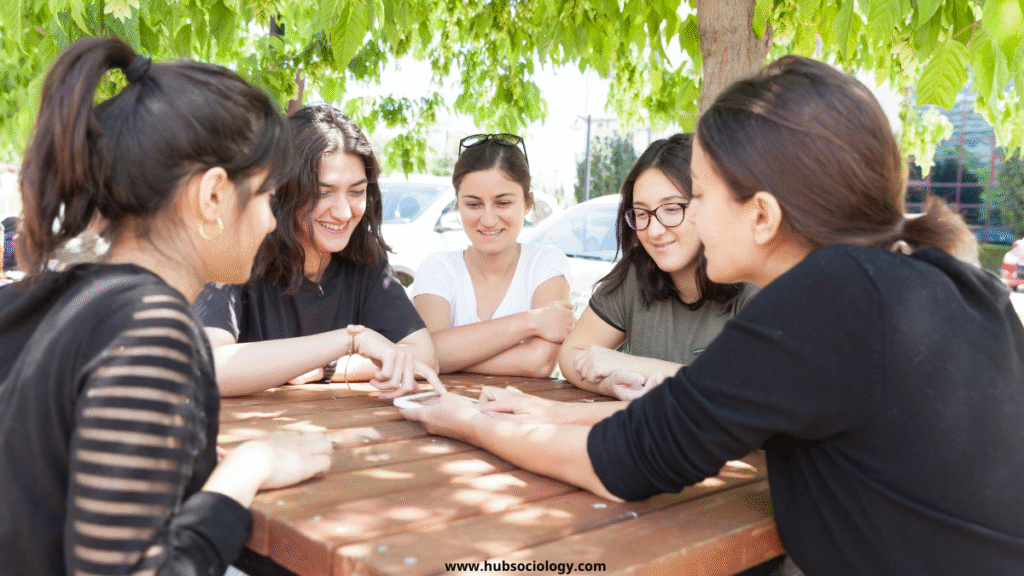Introduction
The concept of “community” is central to sociology, as it represents one of the fundamental structures that shape human interaction, social cohesion, and collective identity. Sociologists have long debated the definition, characteristics, and evolution of communities, particularly in the context of modernization, urbanization, and globalization. This article explores the sociological perspectives on community, examining key theories, types of communities, and their transformations in contemporary society.
Defining Community in Sociology
A community is generally understood as a group of people who share common values, interests, or geographical proximity and engage in sustained social interaction. However, sociologists have provided more nuanced definitions based on different theoretical frameworks.

1. Classical Sociological Perspectives
- Ferdinand Tönnies (Gemeinschaft and Gesellschaft):
Tönnies distinguished between Gemeinschaft (community) and Gesellschaft (society). Gemeinschaft refers to traditional, close-knit communities based on kinship, shared beliefs, and emotional bonds (e.g., rural villages). In contrast, Gesellschaft describes modern, impersonal societies driven by rationality, contracts, and individualism (e.g., urban cities). - Emile Durkheim (Mechanical and Organic Solidarity):
Durkheim’s concepts parallel Tönnies’ ideas. Mechanical solidarity exists in small, homogeneous communities where people share similar lifestyles and collective consciousness. Organic solidarity characterizes complex societies where interdependence arises from specialization and division of labor. - Max Weber (Social Action and Community):
Weber highlighted that people’s subjective interpretations of their interactions shape communities. He made a distinction between associative (based on common interests) and communal (based on emotional bonds) relationships.
2. Modern and Contemporary Definitions
Contemporary sociologists expand on these ideas, recognizing that communities are not solely bound by geography but also by virtual spaces, interests, and identities. Some key aspects include:
- Shared norms and values
- Social cohesion and collective identity
- Networks of interaction (both physical and digital)
- Sense of belonging and mutual support
Types of Communities
Sociologists categorize communities based on different criteria, including structure, function, and social bonds.
1. Geographic (Locational) Communities
These are traditional communities, like towns, villages, or neighborhoods, that are characterized by their physical closeness. Examples include:
- Rural communities – Small, tightly-knit groups with strong traditions.
- Urban communities – Larger, more diverse, and often fragmented due to urbanization.
2. Non-Geographic (Relational) Communities
These communities are based on shared interests, identities, or social networks rather than location. Examples include:
- Ethnic or cultural communities – Groups united by heritage, language, or religion (e.g., diaspora communities).
- Professional communities – Groups formed around occupations (e.g., medical professionals, teachers).
- Virtual communities – Online groups interacting through social media, forums, or gaming platforms.
3. Imagined Communities (Benedict Anderson)
Anderson introduced the idea of “imagined communities,” where members perceive a shared identity despite never meeting all other members (e.g., nations, global fan bases).
The Changing Nature of Community in Modern Society
Modernization, globalization, and digitalization have significantly altered traditional community structures.

1. Decline of Traditional Communities (Urbanization and Industrialization)
- As societies shift from agrarian to industrial and post-industrial economies, close-knit rural communities diminish.
- Urbanization leads to more impersonal, transient social interactions.
2. Rise of Virtual Communities
- Social media, online forums, and digital platforms create new forms of belonging.
- These communities transcend geographical barriers but may lack deep emotional bonds.
3. Hybrid Communities (Glocalization)
- Many communities now blend local and global influences (e.g., immigrant communities maintaining cultural ties while adapting to new environments).
Theoretical Debates on Community
1. Loss of Community Thesis
Some sociologists argue that modernization erodes traditional community bonds, leading to social fragmentation (e.g., Robert Putnam’s Bowling Alone on declining social capital).
2. Transformation (Not Decline) of Community
Others contend that communities are not disappearing but evolving. New forms of solidarity emerge through digital networks and interest-based groups.
3. Networked Individualism (Barry Wellman)
Wellman suggests that individuals now maintain multiple, loosely connected networks rather than relying on single, tightly-bound communities.
Functions of Community in Society
Communities serve several sociological functions:
- Social Support – Provides emotional and material assistance.
- Socialization – Transmits norms, values, and culture.
- Social Control – Reinforces conformity through informal norms.
- Collective Identity – Fosters a sense of belonging.
- Economic Cooperation – Facilitates shared labor and resources.
Challenges Facing Modern Communities
- Fragmentation – Weakening of traditional bonds due to mobility and individualism.
- Inequality and Exclusion – Some communities marginalize certain groups (e.g., racial or economic segregation).
- Digital Divide – Unequal access to virtual communities exacerbates social disparities.
Conclusion
The sociological study of community reveals its dynamic and multifaceted nature. While traditional geographic communities may be declining, new forms of social cohesion emerge through digital and interest-based networks.

Understanding these shifts helps sociologists address challenges related to social isolation, inequality, and identity in an increasingly interconnected yet fragmented world. The concept of community remains vital in analyzing how individuals form connections, construct identities, and navigate societal changes.
Do you like this this Article ? You Can follow as on :-
Facebook – https://www.facebook.com/hubsociology
Whatsapp Channel – https://whatsapp.com/channel/0029Vb6D8vGKWEKpJpu5QP0O
Gmail – hubsociology@gmail.com
Topic related question
5-Mark Questions (Short Answers)
- Define ‘community’ from a sociological perspective.
- Differentiate between Gemeinschaft and Gesellschaft as given by Ferdinand Tönnies.
- What is the difference between mechanical and organic solidarity according to Durkheim?
- Name and briefly explain two types of non-geographic communities.
- How does Benedict Anderson define an “imagined community”?
- What is the ‘loss of community’ thesis in sociology?
- How do virtual communities differ from traditional communities?
- Give two functions of a community in society.
- What is ‘networked individualism’ as proposed by Barry Wellman?
- How does urbanization affect traditional community structures?
10-Mark Questions (Brief Explanations/Essays)
- Explain Tönnies’ concepts of Gemeinschaft and Gesellschaft with suitable examples.
- Discuss Durkheim’s views on mechanical and organic solidarity in the context of community.
- What are the different types of communities in sociology? Explain with examples.
- Analyze the impact of digital technology on modern communities.
- How does globalization influence traditional and new forms of communities?
- Evaluate the argument that modern society has led to the decline of community life.
- Explain the concept of ‘imagined communities’ and provide an example.
- What are the key functions of a community in maintaining social order?
- How do ethnic and professional communities contribute to social identity?
- Discuss the challenges faced by communities in urban societies.
15-Mark Questions (Detailed Essays)
- Critically examine the sociological perspectives on community, including the views of Tönnies, Durkheim, and Weber.
- “Modernization has transformed but not destroyed communities.” Discuss this statement with reference to contemporary society.
- Analyze the role of virtual communities in today’s digital age. Are they replacing traditional communities?
- Compare and contrast rural and urban communities in terms of social cohesion, relationships, and challenges.
- How does Benedict Anderson’s concept of ‘imagined communities’ apply to nationalism and global identities?
- Discuss the impact of globalization on local communities. Does it lead to cultural homogenization or hybrid communities?
- Evaluate the ‘loss of community’ debate in sociology. Do you agree that traditional communities are disappearing?
- How do social media and digital platforms redefine the meaning of community in the 21st century?
- What are the major challenges faced by communities in a rapidly changing world? Suggest possible solutions.
- “Communities are no longer bound by geography but by shared interests and identities.” Discuss with relevant examples.

1 thought on “Sociological Concepts of Community: A Comprehensive Analysis”